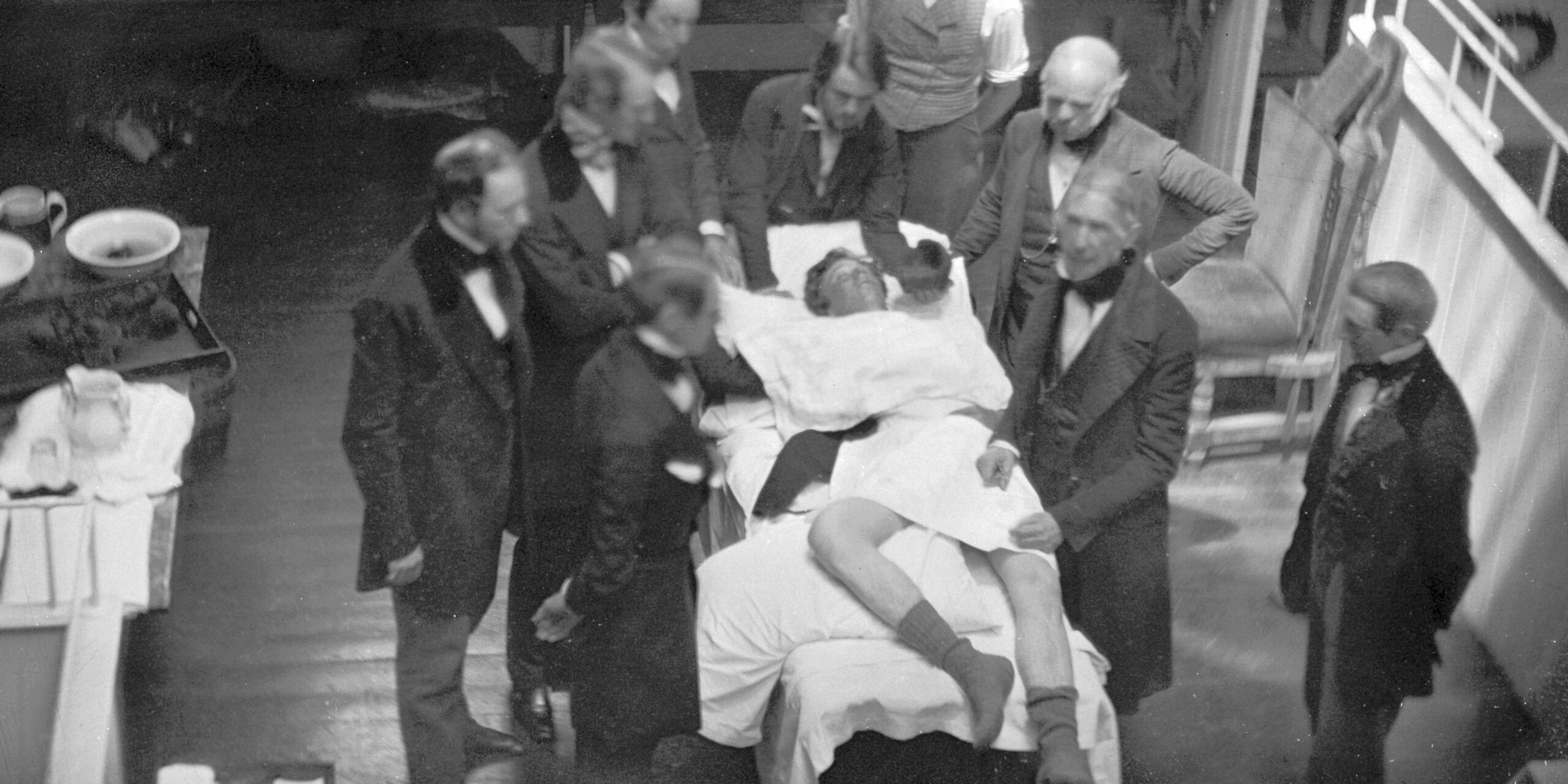Originally published 10 February 1992
A friend recently insisted that I watch the video of a cornea transplant operation on his eye — in close-up living color.
The surgeon’s cookie-cutter blade made its circular incision in the eyeball as neatly as Katrina Witt inscribes a spin on ice. Surgical scissors snipped neatly through milky flesh, carving a crater. The new cornea was dropped in. Then a curved needle stitched the cornea in place, diving and emerging like a sea-bird in water, minute drops of ruby blood welling up at each pinprick hole.
There was poetry about the video. Beauty. Even a faint whiff of divinity.
My friend insists he never felt a thing.
A century-and-a-half ago the slice, snip and stitch of the surgeon’s tools were accompanied by the screams of the fully-conscious patient, who was held to the operating table or chair by as many as six burly surgeon’s assistants. There was little that was poetic or beautiful about surgery in those days. Even a minor surgical procedure such as the removal of a tooth was cause of excruciating pain.
Many surgeons in the first half of the 19th century were knowledgeable and skilled. Nevertheless, they practiced their craft sparingly, knowing that the agony they inflicted upon their patients was often worse than the cure. When cutting was deemed necessary, the surgeon worked with a speed that would now be considered reckless, to minimize the patient’s torment.
Surgically-inflicted pain, like public executions, had its aficionados. Operating theaters were places of morbid entertainment, attended not only by physicians and medical students, but also the general public. In 1830, an operation in London for the removal of a giant tumor was attended by 680 curious onlookers. The wretched patient’s death was attributed to prolonged exposure to the poisonous exhalations of so many humans.
A medical revolution
Then, on Friday, October 16, 1846, before a large, skeptical crowd of onlookers in the operating theater of Massachusetts General Hospital, William Morton put a patient to sleep with ether. The attending surgeon, John Warren, thereupon removed a tuberculous gland from the patient’s neck, and stitched up the wound.
“Did you feel anything?” Warren is said to have asked the groggy patient as he stirred from sleep.
“I thought I felt someone scratching at my neck,” the patient replied.
The discovery of anesthetics made of the surgeon’s unbearable craft a bearable and sometimes beautiful art.
A century and a half after Morton’s revolutionary demonstration, scientists still aren’t sure how anesthetics work.
The standard theory is the so-called lipid hypothesis. Lipids are fatty, oily substances that are common in nerve cell membranes (the membrane is the enclosing wall of a cell, made of lipids and proteins). According to this view, anesthetics — such as ether — dissolve in nerve cell lipids, somehow modifying the cell’s ability to transmit pain, perhaps by making the cell membrane more liquidy than it normally is.
The lipid theory had its origin in the 1890s when scientists observed that the effectiveness of different anesthetics pretty well matches their ability to dissolve in olive oil.
A lock and key
Now, two British researchers, writing in the January 11 [1992] issue of the journal Science, are pushing another theory. Nick Franks and Bill Lieb of the Imperial College of Science, Technology, and Medicine in London believe anesthetics act on the proteins in nerve cell membranes, not the lipids. The effect is not so much like dissolving a substance in oil as fitting a key to a lock. According to the new hypothesis, anesthetic molecules match the shape of nerve protein molecules. By attaching themselves to the proteins, glove-to-hand, anesthetics affect the response of cells to pain stimuli.
The British researchers contrived elegant experiments to prove their theory. For example, one widely-used anesthetic, isoflurane, comes in molecules of two shapes, mirror images of each other (like right- and left-handed gloves) but otherwise chemically identical. The two kinds of molecules should dissolve equally well in lipids, as they do in oil, but not attach themselves with equal efficiency to proteins because of their different shapes (a left-handed glove will not fit a right hand). Franks and Lieb obtained purified isoflurane of both kinds and compared the effects on the nerve cells of snails. The effects were not equal — as the protein theory predicts.
Anesthetics currently in use have dangerous side effects. They depress the cardiovascular and respiratory systems as well as causing unconsciousness; in other words, they act like skeleton keys that fit many locks. If the protein theory turns out to be correct, it will offer the possibility of custom-designing anesthetics to match more exactly the shapes of proteins in the brain — like keys cut to fit specific locks. The use of anesthetics will be made safer and more effective.
The discovery of anesthetics in the mid-19th century was a matter of luck, pluck, and not a little hocus-pocus. We may now be on the threshold of an era when the control of surgical pain — and other kinds of pain — moves from white magic to molecular engineering.



